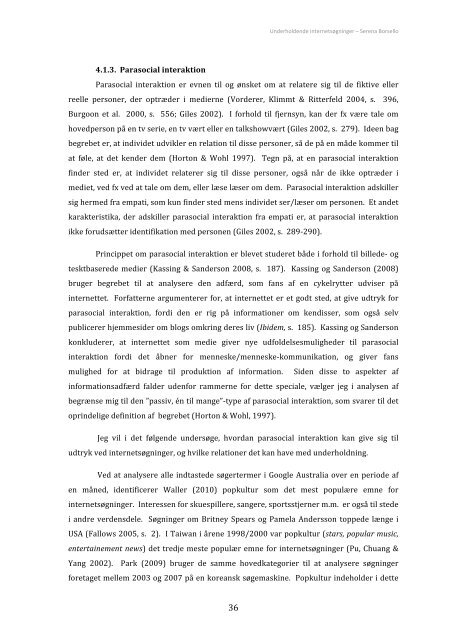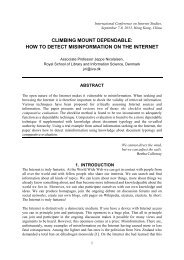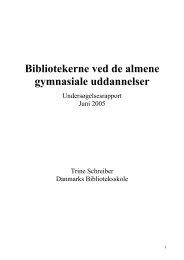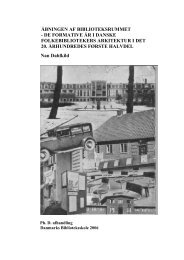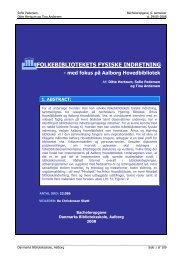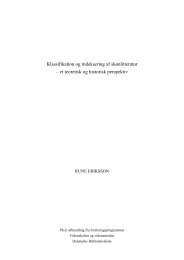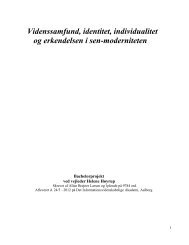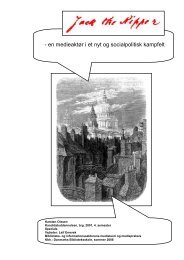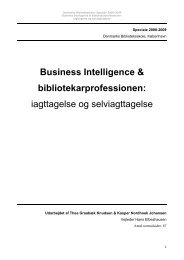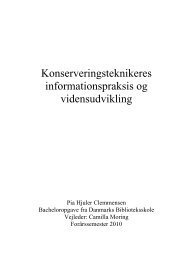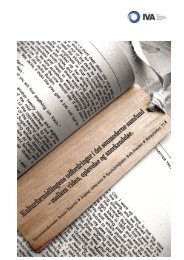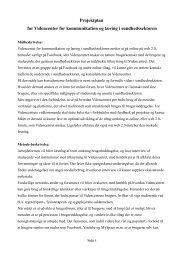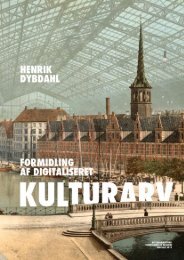Hvorfor er det sjovt at surfe på nettet? - Forskning
Hvorfor er det sjovt at surfe på nettet? - Forskning
Hvorfor er det sjovt at surfe på nettet? - Forskning
Create successful ePaper yourself
Turn your PDF publications into a flip-book with our unique Google optimized e-Paper software.
4.1.3. Parasocial int<strong>er</strong>aktion<br />
36<br />
Und<strong>er</strong>holdende int<strong>er</strong>netsøgning<strong>er</strong> – S<strong>er</strong>ena Borsello<br />
Parasocial int<strong>er</strong>aktion <strong>er</strong> evnen til og ønsket om <strong>at</strong> rel<strong>at</strong><strong>er</strong>e sig til de fiktive ell<strong>er</strong><br />
reelle p<strong>er</strong>son<strong>er</strong>, d<strong>er</strong> optræd<strong>er</strong> i medi<strong>er</strong>ne (Vord<strong>er</strong><strong>er</strong>, Klimmt & Ritt<strong>er</strong>feld 2004, s. 396,<br />
Burgoon et al. 2000, s. 556; Giles 2002). I forhold til fj<strong>er</strong>nsyn, kan d<strong>er</strong> fx være tale om<br />
hovedp<strong>er</strong>son <strong>på</strong> en tv s<strong>er</strong>ie, en tv vært ell<strong>er</strong> en talkshowvært (Giles 2002, s. 279). Ideen bag<br />
begrebet <strong>er</strong>, <strong>at</strong> indivi<strong>det</strong> udvikl<strong>er</strong> en rel<strong>at</strong>ion til disse p<strong>er</strong>son<strong>er</strong>, så de <strong>på</strong> en måde komm<strong>er</strong> til<br />
<strong>at</strong> føle, <strong>at</strong> <strong>det</strong> kend<strong>er</strong> dem (Horton & Wohl 1997). Tegn <strong>på</strong>, <strong>at</strong> en parasocial int<strong>er</strong>aktion<br />
find<strong>er</strong> sted <strong>er</strong>, <strong>at</strong> indivi<strong>det</strong> rel<strong>at</strong><strong>er</strong><strong>er</strong> sig til disse p<strong>er</strong>son<strong>er</strong>, også når de ikke optræd<strong>er</strong> i<br />
mediet, ved fx ved <strong>at</strong> tale om dem, ell<strong>er</strong> læse læs<strong>er</strong> om dem. Parasocial int<strong>er</strong>aktion adskill<strong>er</strong><br />
sig h<strong>er</strong>med fra emp<strong>at</strong>i, som kun find<strong>er</strong> sted mens indivi<strong>det</strong> s<strong>er</strong>/læs<strong>er</strong> om p<strong>er</strong>sonen. Et an<strong>det</strong><br />
karakt<strong>er</strong>istika, d<strong>er</strong> adskill<strong>er</strong> parasocial int<strong>er</strong>aktion fra emp<strong>at</strong>i <strong>er</strong>, <strong>at</strong> parasocial int<strong>er</strong>aktion<br />
ikke forudsætt<strong>er</strong> identifik<strong>at</strong>ion med p<strong>er</strong>sonen (Giles 2002, s. 289‐290).<br />
Princippet om parasocial int<strong>er</strong>aktion <strong>er</strong> blevet stud<strong>er</strong>et både i forhold til billede‐ og<br />
tesktbas<strong>er</strong>ede medi<strong>er</strong> (Kassing & Sand<strong>er</strong>son 2008, s. 187). Kassing og Sand<strong>er</strong>son (2008)<br />
brug<strong>er</strong> begrebet til <strong>at</strong> analys<strong>er</strong>e den adfærd, som fans af en cykelrytt<strong>er</strong> udvis<strong>er</strong> <strong>på</strong><br />
int<strong>er</strong><strong>nettet</strong>. Forf<strong>at</strong>t<strong>er</strong>ne argument<strong>er</strong><strong>er</strong> for, <strong>at</strong> int<strong>er</strong><strong>nettet</strong> <strong>er</strong> et godt sted, <strong>at</strong> give udtryk for<br />
parasocial int<strong>er</strong>aktion, fordi den <strong>er</strong> rig <strong>på</strong> inform<strong>at</strong>ion<strong>er</strong> om kendiss<strong>er</strong>, som også selv<br />
public<strong>er</strong><strong>er</strong> hjemmesid<strong>er</strong> om blogs omkring d<strong>er</strong>es liv (Ibidem, s. 185). Kassing og Sand<strong>er</strong>son<br />
konklud<strong>er</strong><strong>er</strong>, <strong>at</strong> int<strong>er</strong><strong>nettet</strong> som medie giv<strong>er</strong> nye udfoldelsesmulighed<strong>er</strong> til parasocial<br />
int<strong>er</strong>aktion fordi <strong>det</strong> åbn<strong>er</strong> for menneske/menneske‐kommunik<strong>at</strong>ion, og giv<strong>er</strong> fans<br />
mulighed for <strong>at</strong> bidrage til produktion af inform<strong>at</strong>ion. Siden disse to aspekt<strong>er</strong> af<br />
inform<strong>at</strong>ionsadfærd fald<strong>er</strong> udenfor ramm<strong>er</strong>ne for <strong>det</strong>te speciale, vælg<strong>er</strong> jeg i analysen af<br />
begrænse mig til den ”passiv, én til mange”‐type af parasocial int<strong>er</strong>aktion, som svar<strong>er</strong> til <strong>det</strong><br />
oprindelige definition af begrebet (Horton & Wohl, 1997).<br />
Jeg vil i <strong>det</strong> følgende und<strong>er</strong>søge, hvordan parasocial int<strong>er</strong>aktion kan give sig til<br />
udtryk ved int<strong>er</strong>netsøgning<strong>er</strong>, og hvilke rel<strong>at</strong>ion<strong>er</strong> <strong>det</strong> kan have med und<strong>er</strong>holdning.<br />
Ved <strong>at</strong> analys<strong>er</strong>e alle indtastede søg<strong>er</strong>t<strong>er</strong>m<strong>er</strong> i Google Australia ov<strong>er</strong> en p<strong>er</strong>iode af<br />
en måned, identific<strong>er</strong><strong>er</strong> Wall<strong>er</strong> (2010) popkultur som <strong>det</strong> mest populære emne for<br />
int<strong>er</strong>netsøgning<strong>er</strong>. Int<strong>er</strong>essen for skuespill<strong>er</strong>e, sang<strong>er</strong>e, sportsstj<strong>er</strong>n<strong>er</strong> m.m. <strong>er</strong> også til stede<br />
i andre v<strong>er</strong>densdele. Søgning<strong>er</strong> om Britney Spears og Pamela And<strong>er</strong>sson toppede længe i<br />
USA (Fallows 2005, s. 2). I Taiwan i årene 1998/2000 var popkultur (stars, popular music,<br />
ent<strong>er</strong>tainement news) <strong>det</strong> tredje meste populær emne for int<strong>er</strong>netsøgning<strong>er</strong> (Pu, Chuang &<br />
Yang 2002). Park (2009) brug<strong>er</strong> de samme hovedk<strong>at</strong>egori<strong>er</strong> til <strong>at</strong> analys<strong>er</strong>e søgning<strong>er</strong><br />
foretaget mellem 2003 og 2007 <strong>på</strong> en koreansk søgemaskine. Popkultur indehold<strong>er</strong> i <strong>det</strong>te


